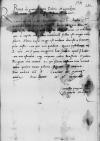List #1756
Bona Sforza do Ioannes DANTISCUSCracow, 1537-10-28
| odebrano [1537]-11-11 Rękopiśmienne podstawy źródłowe:
Pomocnicze podstawy źródłowe:
Publikacje:
| ||||||||||||
Tekst + aparat krytyczny + komentarzZwykły tekstTekst + komentarzTekst + aparat krytyczny
Reveren(do) or Reveren(dissimo)⌈Reveren(do)Reveren(do) or Reveren(dissimo)⌉
in Christo Patri, Domino
Reveren(de) in Christo Pater, sincere nobis dilecte.
Attulit et reddidit nobis
Quare postulamus a Paternitate Vestra, ut si quam imaginem huic similem apud se habet, eam non ostendat neque cuiquam extra
Bene valeat Vestra Paternitas.
Commissio propria


 BCz 243, p. 274
BCz 243, p. 274